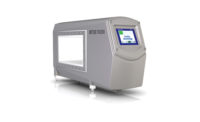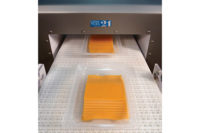Processors of dairy foods and beverages understand that the detection of metal and other contaminants is critical to food safety efforts. Contaminant-related recalls not only are expensive, but also damaging to a brand’s reputation.
But such efforts present a number of challenges resulting from varying product and packaging conditions.
“Most dairy products are wet, cold and may have some salt content,” Bob Ries, lead product manager, X-ray and inspection and metal detection for Waltham, Mass.-based Thermo Fisher Scientific, pointed out. “They can change consistency over the course of a production run due to small changes in ingredients or temperature. … Additionally, dairy processors are expanding their range of packaging materials, increasingly using shelf-stable, biodegradable, metalized and transparent properties to meet growing consumer preferences for natural [and] organic dairy products.”
Further complicating efforts is a shortage of labor — both skilled and in general — on dairy processor’s part, noted Jorge Izquierdo, vice president of market development for PMMI, Reston, Va.
The good news? Recent advances in X-ray, metal-detection and inspection systems aim to address many of dairy processors’ challenges.
Metals meet their match
On the metal-detection front, thoroughness is key. To improve results here, Thermo Fisher Scientific recently introduced the Sentinel 5000 multiscan metal detector. The first-of-its-kind platform quickly scans as many as five frequencies at once to enable dairy processors to identify contaminants that include ferrous, non-ferrous and stainless steel materials — including contaminants that could be overlooked in single-frequency scan applications, Ries said.
“We tested shingled sliced cheese on a single-frequency metal detector and the Sentinel,” he noted. “The result was that the Sentinel picked up metal objects in the cheese that were 60% smaller in volume as compared to our previous-generation single-frequency metal detector.”
Metal detection thoroughness also is top of mind for Bunting Magnetics Co., Newton, Kan. The company aims to improve sensitivity with each metal-detection upgrade or innovation it introduces, explained Barry Voorhees, product manager, metal detection. For example, Bunting Magnetics introduced imagePHASE a few years ago.
“It allows the user to gain better sensitivities for products that were typically hard to metal-detection inspect,” he said. “Products such as cheese, yogurt and ice cream exhibit some sort of product effect. The recognition software allows us to offer better performance to improve sensitivities.”
This year, Bunting Magnetics debuted its tripleFREQUENCY and autoTEST upgrades, Voorhees said.
“If a customer is processing and inspecting different varieties of products, tripleFREQUENCY is a great option,” he noted. “The autoTEST option assists the user in the validation of their metal detection system for their quality assurance process.”
Magnets get upgrades
New this year from Eriez Manufacturing Co., Erie, Pa., are two metal detector/magnetic separator “double team” systems that protect against ferrous and nonferrous metal contamination, said Craig Lorei, assistant market manager – light industry. The Liquid Line Double Team system uses a Magnetic B Trap and an Xtreme Liquid Line Metal Detector with automatic reject, while the Vertical Double Team system — suitable for free-falling bulk materials — features an easy-to-clean Magnetic Grate-in-Housing and a Vertical Xtreme Metal Detector with reject.
“Both Double Team systems use Eriez RE7HP Tube Magnets — the strongest available in the industry — to remove ferrous contamination from the product flow first, thus enhancing product quality and reducing rejected material from the downstream metal detector with automatic reject,” he explained. “The metal detector’s primary function then is to detect and reject non-magnetic tramp metals, including aluminum and stainless steel.”
And Powder-Solutions Inc., Chanhassen, Minn., recently introduced MAG-RAM self-cleaning grate magnets. The USDA dairy-accepted magnets collect ferrous metal fragments without human interaction.
According to the company, the design pneumatically retracts the magnet rods, then rotates the rods and wipes the magnetic materials to the end and into a collection chamber. The rotation provided by the cleaning equalizes abrasive wear while avoiding material buildup on the rods.
Voorhees noted that Bunting Magnetics historical roots are in metal separation — and the company is continually evaluating better grades of magnetic materials, as well as its “circuit” design.
“Our circuit will determine the effectiveness of the magnet, which is typically in terms of pounds-force it takes to remove a ferrous contaminant from the surface of the magnet,” he said. “We introduced NUHI, which is the highest pull-value cartridge magnet that we have seen available on the market.”
Detecting more than metals
Recent detection-related improvements also focus on non-metal contaminants. For example, Anritsu, Morgan Hill, Calif., designed its XR75 X-ray systems specifically to improve detection of lower-density contaminants such as glass and stone — and reduce system operating costs at the same time, said Eva Bar, marketing and communications manager.
“Outside inspection, all industries are moving towards increased data collection, so addressing those needs are a current focus” of Antritsu, she added. “Current and ongoing improvements in data collection capabilities are focused on storage of data images directly correlating to individual products and product lots for enhanced tracking-n-tracing capability.”
For its part, Eagle Product Inspection, Tampa, Fla., offers X-ray systems that detect a wide range of contaminants in dairy products that include butter, yogurt, ice cream, cheese and powdered products such as milk beverages, said Christy Draus, marketing manager.
“Contaminants such as glass, metal fragments, mineral stone, calcified bone and some rubber and plastic compounds can be identified and removed from the production line, preventing these potentially harmful foreign bodies from reaching consumers,” she said.
The systems also can simultaneously measure fill levels and mass, inspect seals and count components, Draus noted. And detection ability is not impaired by foil and metalized film packaging or changes in product temperature or moisture content.
New from Mettler Toledo Product Inspection, Ithaca, N.Y., is the X38 Pipeline X-ray inspection system.
“The system inspects pumped liquid and semi-liquid products such as yogurts for contamination, including metal, glass, stone and/or high-density plastics,” noted Lanel Menezes, X-ray product manager for the Tampa, Fla.-based division. “Contaminated product segments are rejected with minimal loss of valuable product.”
Speed is also an advantage — the system can inspect and reject contaminated products at throughput speeds of up to 14 metric tons per hour, the company said.
Also new on the X-ray inspection front is the Ishida IX-G2 dual-energy X-ray system from Hayward, Calif.-based Heat and Control. Based on medical X-ray absorptiometry, the system uses dual-energy sensors to provide “highly sensitive detection of low-density and thin foreign objects,” explained Todd Grube, product manager, inspection systems. It compares images from two different X-ray energy levels to analyze the absorption of X-rays and detect foreign objects by material type and density.
“This process improves detection of low-density objects such as thin pieces of metal, glass, shell, bone and rubber in overlapping products and those with irregular surfaces,” he said. “IX-G2 technology also helps reduce product giveaway and false rejects.”
Calling the system the “Swiss Army knife of inspection systems,” Grube said it also includes a weight verification function and detects incomplete filling, missing items, product defects, incorrect alignment and product trapped in package seals.
Digital sorters also help processors find and remove a wide range of contaminants, noted Marco Azzaretti, advanced inspection systems product manager for Key Technology, Walla Walla, Wash. Key Technology’s new VERYX digital sorters feature multi-sensor Pixel Fusion that combines pixel-level input from multiple cameras and laser sensors to clearly differentiate between good product and defective product/foreign materials.
“With Pixel Fusion, VERYX consistently removes the most difficult-to-detect foreign material and defects without false rejects to maximize product quality and process yield,” he said. “In 2017, Key introduced VERYX for cheese. With new software, algorithms and material-handling subsystems specifically designed for sorting cheese products, this advanced sorter helps cheese processors enhance their product quality and maximize food safety.”
Forge a partnership
To get the most out of inspection and detection equipment, Bar advises dairy processors to develop strong partnerships with their equipment suppliers.
“We strive to effectively advance the quality of our customer’s products through a high level of understanding of quality goals to ensure proper installations and application of advanced, reliable and accurate inspection technology supported by performance-based service, training and support,”
she said.







